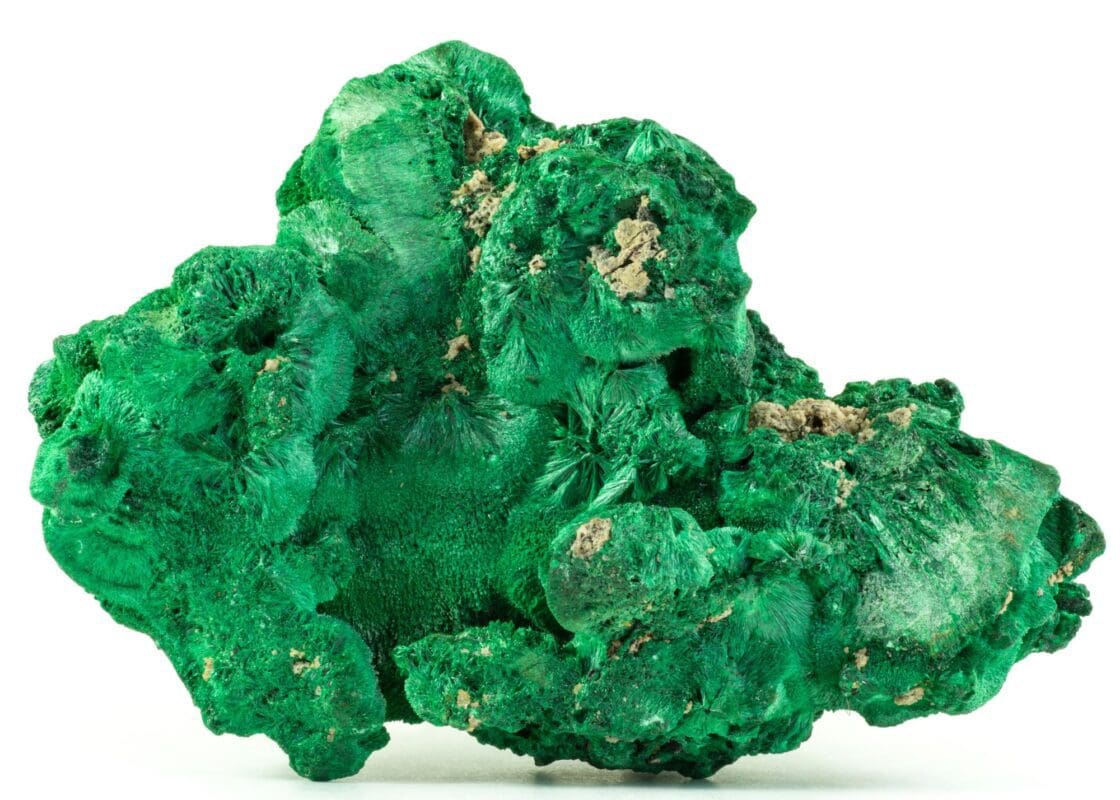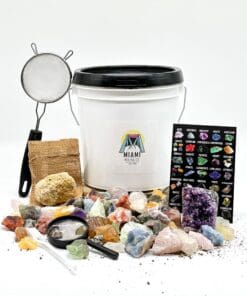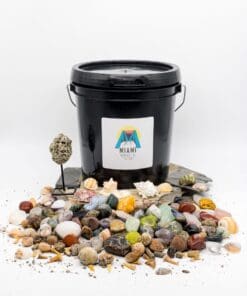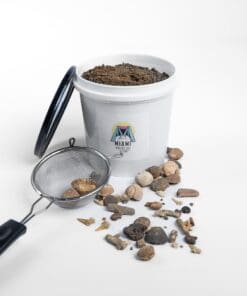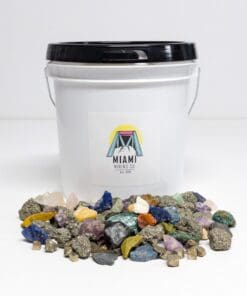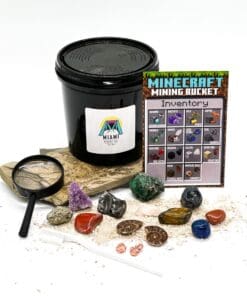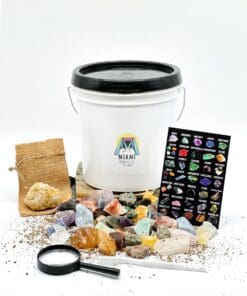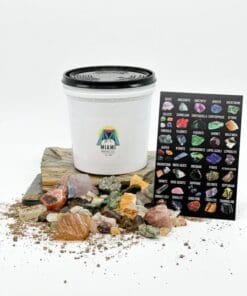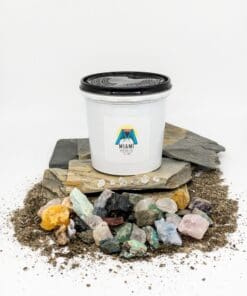Wisconsin’s Geology Revealed: Gem Mining Hotspots and Hints
Gem mining is not only an adventure but a voyage into the heart of the Earth. In Wisconsin, this pastime has been both a historic and recreational venture, inviting both professionals and hobbyists to unearth the natural wonders below. This article will guide you through the gems you might encounter, where to find them, and how to transform your find into a cherished treasure.
The Most Popular Gemstones in Wisconsin
Wisconsin’s geology provides a diverse and intriguing mix of gemstones. Here, we’ve broken down the gemstones found in the state into two categories: rare finds that are a gem hunter’s dream and more common treasures that still offer unique beauty.
Rare Gemstones in Wisconsin:
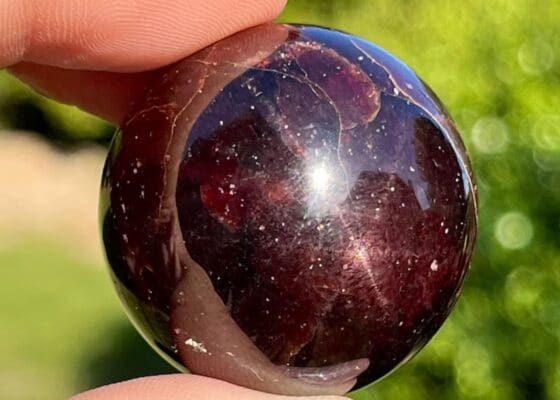
| Gemstone | Description |
|---|---|
| Lake Superior Agate | Characterized by its distinct concentric bands, often in red hues due to iron-rich minerals. |
| Star Garnet | A garnet variant that, when polished, showcases a radiant four-rayed star due to inclusions. |
| Beryl | A mineral that can be colorless or tinted green (emerald), blue, yellow, or other shades. |
| Epidote | A greenish-black or pistachio green crystal that often occurs in prismatic crystals. |
| Tourmaline | Comes in various colors, but the black variety (schorl) is more common in Wisconsin. |
Common Gemstones in Wisconsin:

| Gemstone | Description |
|---|---|
| Quartz | Colorless, hard crystal that can take on colors like amethyst (purple) or citrine (yellow). |
| Jasper | An opaque variety of chalcedony, usually found in red, yellow, brown, or green. |
| Chert | A sedimentary rock, usually in dark colors, that’s often used for tool-making due to its hardness. |
| Calcite | A mineral often found in limestone caves, known for its clear to white or light-colored crystals. |
| Dolomite | Similar to calcite but often has a more pinkish hue. |
| Pyrite | Known as “fool’s gold,” it has a metallic luster and gold color. |
| Galena | A shiny, metallic, and dense mineral known as the primary ore of lead. |
| Malachite | A vibrant green mineral used as an ore of copper and for ornamental purposes. |
| Hematite | Often presenting a rust-red streak, it’s an iron oxide mineral that can be magnetic. |
| Barite | Heavy mineral that comes in a range of colors but is commonly clear or white. |
Wisconsin’s gem variety offers something for everyone, from those seeking a special rare find to enthusiasts content with the state’s more abundant offerings.
Top Gem Mining Locations in Wisconsin
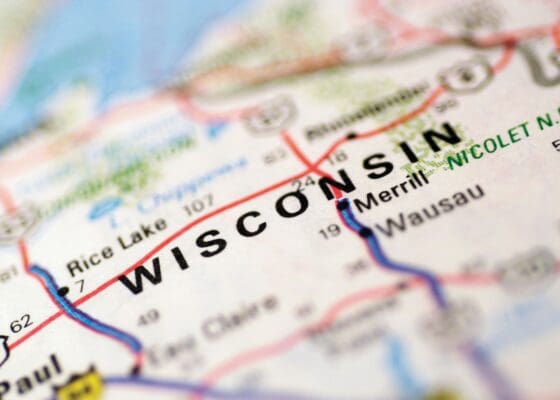
- Dells Mining Co., Wisconsin Dells: A major attraction, the Dells Mining Co. offers a mix of gem hunting and jewelry buying experiences. Open daily from 9 AM to 10 PM, fees start from $20 depending on the size of the gem bucket you select.
- Gemstone Mining at Howe’s, Green Bay: A family-friendly spot, Howe’s provides mining rough through which you can discover emeralds, arrowheads, and even fossils. They operate from May to September, 10 AM to 5 PM, with a standard fee of $15 per bag of mining rough.
- Cave of the Mounds, Blue Mounds: Renowned for its natural geological beauty, this spot lets you pan for gemstones and fossils. Open year-round, timings vary by season. The gem panning experience is an additional $6 with any tour ticket.
- Wisconsin Gold Mining Co., Eau Claire: While primarily known for gold, prospectors can also uncover a variety of gemstones. Open from June to September, 8 AM to 6 PM. Fees start at $10 for a small pan of dirt.
- Mineral Point Gem Mine, Mineral Point: Dive into Wisconsin’s mining history while prospecting for quartz, jasper, and even pyrite. They operate from April to October, 9 AM to 5 PM. Panning bags start at $12.
- Door County Rock and Gem, Sturgeon Bay: A delightful spot for families, here you can sift for a range of semi-precious stones. Open daily from 10 AM to 5 PM, the mining experience is $8 for a small bag of sand.
- Crystal Cave, Spring Valley: Beyond the stunning cave tours, you can also pan for gems. Open from April to October, panning costs are $5 with any tour.
- Rush Creek Adventures & Gem Mine, Augusta: Hunt for over 50 different types of gemstones in this expansive site. Operating from May to September, 9 AM to 6 PM, gem bags start at $10.
- Geode Hunting Ground, Waukesha: A unique site dedicated to unearthing geodes, which, when cracked open, reveal stunning inner crystal structures. Open weekends from June to August, 10 AM to 4 PM. Prices vary based on the size of the geode.
- Bear Den Zoo Gem Mining, Waterford: A combination of a petting zoo and gem mining experience, it’s a fun-filled destination for kids and adults alike. Open from April to November, 10 AM to 2 PM on weekdays and 9 AM to 5 PM on weekends. Mining starts at $6 per bag.
From the bustling activity of major mining centers to the serene beauty of natural caves, Wisconsin offers a diverse array of gem mining experiences for enthusiasts of all ages.
History of Gem Mining in Wisconsin

The history of gem mining in Wisconsin is a tapestry interwoven with tales of ambition, discovery, and the profound appreciation for the natural wonders beneath its soil. Long before modern prospectors set foot on Wisconsin’s terrains, the region’s geological riches were known and revered by the Native American tribes. The Lake Superior Agate, in particular, was cherished for its captivating beauty and intricate designs, often used in ceremonies and as trade items.
As European settlers began to explore and establish themselves in Wisconsin during the 19th century, the potential of its mineral wealth became more evident. It wasn’t just the quest for gold or silver that drew people to Wisconsin’s rivers and open grounds; it was the allure of the state’s diverse gemstones. Towns near mining areas like Mineral Point quickly flourished, turning into bustling hubs for miners, traders, and gem enthusiasts.
One of the notable periods in Wisconsin’s gem mining history is the “Copper Boom” of the mid-1800s. Although the focus was primarily on copper, the operations led to discoveries of other minerals and gemstones, further enhancing the state’s reputation. As the years progressed, mining shifted from a commercial, large-scale operation to a more recreational activity. Families started visiting mining sites, sifting through the earth and rivers, hoping to find a hidden gem to take home as a souvenir.
While gem mining in Wisconsin has certainly evolved, it remains grounded in the state’s legacy. The state has witnessed several mining booms, from the quest for lead and zinc in the southwest to the gold rushes in the northern regions. Each era has contributed to the rich tapestry of Wisconsin’s mining culture.
Today, numerous gem mining sites across Wisconsin stand as testament to this rich history, offering visitors a chance not only to unearth precious stones but to also connect with a tradition that spans centuries. It’s a journey of discovery — both of the treasures beneath our feet and of Wisconsin’s enduring legacy as a land of geological wonders.
Gem Mining Regulations in Wisconsin

The intricate web of gem mining regulations in Wisconsin underscores the state’s commitment to maintaining a delicate balance between promoting recreational gem hunting and ensuring the preservation of its unique geological heritage. Whether you’re a professional miner or a weekend hobbyist, understanding these regulations is crucial not only for legal considerations but also for ensuring sustainable practices that benefit future generations.
For starters, public lands in Wisconsin often allow casual collection of rocks, minerals, and gemstones. This means individuals can pick up small amounts without the need for any special permit, provided it’s for personal use and not for commercial resale. Such a policy encourages educational outings, allowing families and students to explore the state’s geological wonders firsthand.
However, the keyword here is “small amounts.” Excessive collecting or any form of large-scale mining operations on public lands without proper authorization can lead to legal consequences. This is especially true for lands that are protected or have designated purposes other than mineral collection, such as state parks or conservation areas.
If one is looking towards commercial gem mining or even larger recreational operations, there are clear legal channels to follow. Acquiring the necessary mining permits and land leases is essential. Each permit application is scrutinized based on environmental impact assessments, ensuring the mining activities don’t harm local ecosystems or diminish the land’s long-term value.
Water sources, too, are protected. For those considering riverbed or underwater mining, be aware that Wisconsin’s waterways are monitored to prevent harmful sediment disruption or water pollution. Prospective miners need to ensure their activities don’t upset the delicate freshwater ecosystems.
The state also encourages ethical mining practices. This includes refraining from using harmful chemicals, respecting land boundaries, and restoring land post-mining. Restoration ensures that once the mining activity ceases, the land can recover and continue to support local flora and fauna.
In conclusion, while Wisconsin warmly welcomes all to explore its rich geological offerings, it does so with a keen eye on preservation and sustainability. Before embarking on your gem hunting adventure, it’s advisable to consult with the Wisconsin Department of Natural Resources or local governmental bodies to get accurate, up-to-date information on regulations, permit requirements, and best practices. This proactive approach ensures a respectful and enriching gem mining experience, in harmony with Wisconsin’s cherished landscapes.
Necessary Tools and Equipment for Gem Mining in Wisconsin
Wisconsin’s diverse terrain, from its riverbeds to open mines, demands an equally varied toolkit for the enthusiastic gem hunter. While the thrill of the hunt is undeniable, being equipped with the right tools can transform a day of prospecting from merely enjoyable to incredibly fruitful.
1. Screening and Classifying Tools: Reveal those hidden treasures!
Description: A classic in the gem miner’s toolkit. These are especially useful if you’re exploring Wisconsin’s riverbeds, where sifting through sediment can yield beautiful gemstones. Modern pans come in plastic with ridges, making the process more efficient than the traditional metal pan.


🛒 Explore Top Screening Sets on Amazon
2. Shovels and Trowels: Digging deep or just scratching the surface?
Description: For more delicate work or when dealing with softer grounds, smaller tools like hand trowels or even small brushes can be beneficial.


🛒 Find Quality Shovels and Trowels on Amazon
3. Picks and Hammers: The backbone of any gem hunting endeavor.
Description: For digging into the earth or sand. A sturdy shovel is ideal for more open areas, while a trowel is suited for more precise digging, especially in tighter spaces.


🛒 Check Out Best Picks and Hammers on Amazon
4. Buckets: Your trusted companion for carrying treasures.
Description: To carry and store your finds. Buckets can also be used to transport water or sediment, especially when working away from a direct water source.
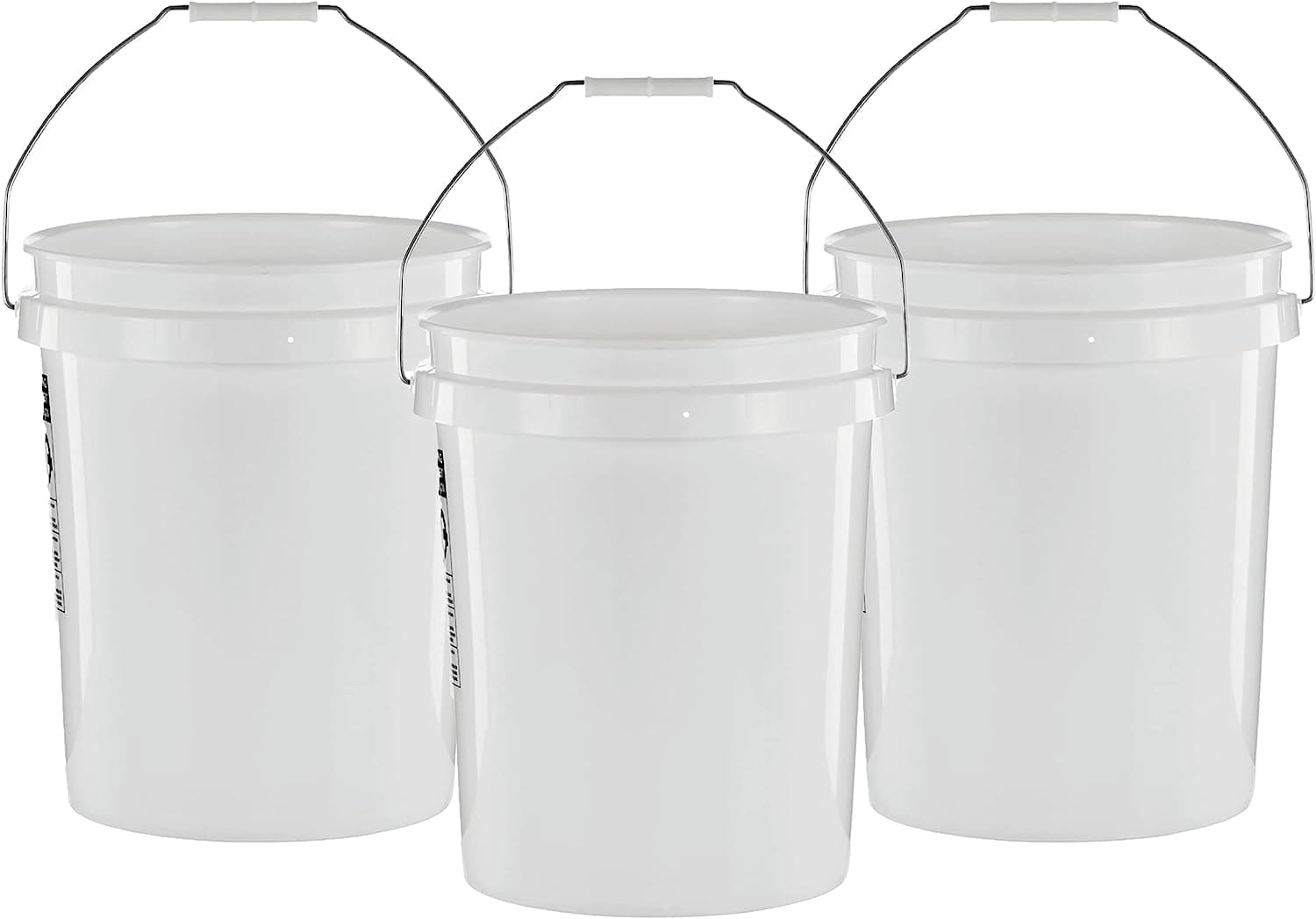

🛒 Shop for Reliable Buckets on Amazon
5. Magnifying Glass: Every detail counts!
Description: These are essential for picking out and examining smaller finds. The magnifying glass allows you to appreciate the intricate details of smaller gemstones and can aid in initial identification.


🛒 Grab Your Magnifying Glass on Amazon
6. Guidebooks and Field Guides: Knowledge at your fingertips.
Description: A gemstone identification book tailored to Wisconsin’s geology can be invaluable. It offers insights into the types of gemstones you might encounter and provides tips on where to look.


🛒 Discover the Best Field Guides on Amazon
7. Containers and Bags: Organize, store, and flaunt your finds.
Description: Small pouches or containers are essential to store and protect the gemstones you find. Soft cloth bags or padded boxes are ideal as they prevent your treasures from getting scratched.


🛒 Shop for Storage Solutions on Amazon
8. First Aid Kit: Better safe than sorry!
Description: Given the adventurous nature of gem hunting, it’s wise to be prepared for minor injuries like cuts or scrapes.


🛒 Secure Your First Aid Kit on Amazon
In essence, gem mining in Wisconsin is not just about having the right tools but also ensuring personal comfort and safety. Being well-prepared maximizes the chances of fruitful discoveries and ensures an enriching, memorable experience amidst Wisconsin’s geological wonders.
Tips and Tricks for Successful Gem Mining in Wisconsin


Gem mining in Wisconsin is a blend of patience, knowledge, and a touch of luck. To bolster your gem hunting endeavors in this geologically rich state, consider these proven tips and tricks:
- Research Before You Head Out: While spontaneity has its charm, a bit of pre-trip research can significantly enhance your success rate. Familiarize yourself with the types of gemstones common in the area you’re visiting to know what to look out for.
- Early Bird Advantage: It’s a popular saying in the gem hunting community that the early bird finds the gems. Starting early gives you an advantage over others, especially in more popular sites, and cooler morning temperatures can make the hunt more comfortable.
- Speak to Locals: Local miners and residents possess a wealth of knowledge. Engaging with them can offer insights into lesser-known spots, recent discoveries, or even specific techniques suited for the region.
- Practice Patience: Gem hunting isn’t always about immediate gratification. It might take hours to find something noteworthy. Patience, combined with persistence, often reaps the most rewarding finds.
- Mind the Environment: Always be aware of your surroundings. This means being cautious near water sources, aware of wildlife, and respectful of the environment. Leave no trace, ensuring the beauty and richness of Wisconsin’s gem sites remain intact for future generations.
- Rotate Sites: If one location isn’t yielding results, don’t hesitate to switch. Different terrains or river bends might offer a refreshing change and increase your chances of discoveries.
- Stay Updated on Weather: Wisconsin’s weather can be unpredictable. Keeping an eye on forecasts ensures you’re not caught off-guard by sudden showers or temperature drops.
- Join a Club: Consider joining a local gem and mineral club. Beyond the camaraderie, these groups often organize group digs, offer workshops, and can be a treasure trove of accumulated knowledge.
- Document Finds: Photographing and noting down the specifics of your finds can be invaluable. Not only does it aid in later identification, but it also helps track patterns or fruitful spots.
- Safety First: Always prioritize your safety. Inform someone of your whereabouts, carry essential communication devices, and be cautious in unfamiliar terrains.
In essence, successful gem mining in Wisconsin is an amalgamation of preparation, respect for nature, and an enduring spirit of curiosity. With these tips in hand, each trip can become a voyage of discovery, unveiling the hidden gems beneath Wisconsin’s diverse landscape.
Handling Your Gemstone Finds


After hours of meticulous searching, feeling the weight of a potential gemstone in your hand is an exhilarating experience. However, the journey doesn’t end with the discovery. Properly handling, cleaning, and storing your finds ensures their longevity and enhances their inherent beauty.
- Initial Cleaning: Once you’ve unearthed a gemstone, remove excess dirt gently with a soft brush. If near water, a quick rinse can help, but be wary of potential fractures in the stone which water can exacerbate.
- Detailed Cleaning at Home: Depending on the gemstone, different cleaning methods apply. Soapy water and a soft toothbrush can work wonders for many stones. However, some minerals may react adversely to chemicals, so research your specific find before deep cleaning.
- Storing: Gemstones, especially in their raw form, can be fragile. Store each gem separately in soft pouches or lined boxes to prevent scratches or damage from other rocks or minerals.
- Documentation: Alongside the gem, maintain a detailed record – where it was found, its weight, dimensions, and any initial identification thoughts. This can be invaluable for future reference or if you decide to get it professionally assessed.
- Professional Identification: While personal research and identification are rewarding, considering a visit to a gemologist or an expert can provide a definitive identity of your find, along with its potential value.
- Displaying: If you wish to showcase your discoveries, consider investing in a display case with individual sections. Proper lighting can also enhance the natural luster and beauty of the gemstones.
- Value Assessment: If you believe you’ve found something of significant value, approach a certified appraiser. They can provide insights into its market value, rarity, and potential buyers if you’re considering selling.
- Learning Basic Lapidary Skills: If you’re drawn to the world of gemstones, learning basic lapidary skills can be rewarding. This art of cutting, shaping, and polishing stones can transform your raw finds into beautiful pieces of jewelry or art.
- Trade or Barter: Engage with the gem hunting community. Trading your finds can help you diversify your collection and learn more about other gemstones.
- Insurance: For especially valuable finds, consider getting them insured. This safeguards your investment and ensures peace of mind.
In conclusion, treating your gemstone finds with care and respect is crucial. They are fragments of Wisconsin’s rich geological tapestry, and with proper handling, they can serve as beautiful keepsakes, telling stories of adventure and discovery for years to come.
Famous Gemstone Finds in Wisconsin
Wisconsin’s gem-hunting history isn’t just marked by the vast numbers of gemstones unearthed, but also by some truly remarkable finds that have gained notoriety, both within and outside the state.
- The Mellen Diamond: Among the most exciting finds is a diamond discovered near Mellen in the early 20th century. While Wisconsin isn’t primarily known for diamonds, this discovery showcased the state’s diverse geological potential.
- Red Gym Jasper: A unique find, this jasper variant is recognizable by its stunning patterns and colors, drawing parallels to the bricks of the historical Red Gym building at the University of Wisconsin-Madison. This gemstone not only captures attention due to its beauty but also because of its symbolic link to Wisconsin’s architectural heritage.
- Lake Superior Agates: While these are more broadly found across the upper Midwest, some of the most exquisite specimens have been discovered along Wisconsin’s part of the Lake Superior shoreline. Characterized by their rich, banded colors, they hold a special place in the heart of many local collectors.
- The Ellsworth Wonder: Unearthed in Pierce County, this enormous smoky quartz crystal cluster weighed in at over 200 pounds. Its size, clarity, and form make it one of the state’s most significant mineralogical finds.
- Galena Lead Ore Specimens: While Galena is commonly associated with Illinois, Wisconsin’s mining history was once dominated by the search for lead. Remarkably well-formed Galena crystals have been discovered in the state, some of which are museum-worthy due to their intricate crystalline structures.
- Wisconsin Moonstone: A feldspar variant, this gem is not as commonly associated with Wisconsin as other states. However, certain locales have yielded exquisite pieces, characterized by their ethereal blue sheen, reminiscent of moonlight.


- Beryl Crystals from Menomonie: While not as abundant as in other regions, Menomonie has been a source of beautifully formed beryl crystals, a testament to the state’s varied mineralogy.
- The Keweenawan Jasper: Found within ancient lava flows in the northern reaches of the state, this gemstone is a vivid, scenic jasper that captures the essence of the state’s volcanic past.
- Door County Corals: These are fossilized remnants of ancient coral reefs, beautifully preserved and found in Door County. They paint a picture of a time when the region was submerged under a tropical sea.
- The Eagle River Ruby: Though Wisconsin isn’t renowned for rubies, this rare find from Eagle River generated considerable excitement, reaffirming the state’s gemological surprises.
These renowned discoveries underscore Wisconsin’s rich geological heritage. Each famous find not only speaks to the state’s mineralogical diversity but also inspires the next generation of gem hunters to explore, hoping to add to this list of distinguished discoveries.
Additional Gem Mining Opportunities
For those who have caught the gem mining bug, Wisconsin’s neighboring states also offer a plethora of opportunities to continue the hunt. Each state boasts its own unique geological landscapes and gemstone treasures:
- Minnesota Gem Mining: Just to the west, Minnesota is renowned for its Lake Superior Agates, and the state’s vast stretches of glacial deposits make it a hotspot for various minerals.
- Iowa Gem Mining: Bordering Wisconsin to the southwest, Iowa’s geodes are a major attraction for gem hunters, with Keokuk being a particularly famous locality.
- Illinois Gem Mining: Directly south of Wisconsin, Illinois is famous for its fluorite deposits, especially in the southern parts where beautiful crystals in varying hues can be unearthed.
- Michigan Gem Mining: To the northeast, across Lake Michigan, the Upper Peninsula of Michigan is a treasure trove, especially for native copper, datolite, and Lake Superior Agates.
- Indiana Gem Mining: Though more to the southeast and not directly neighboring Wisconsin, Indiana offers geode sites and renowned locations for fossil hunting, adding a different dimension to the gem and mineral exploration journey.
Expanding your gem hunting adventures to Wisconsin’s neighbors can offer a refreshing change in landscapes and targets, deepening appreciation for the Midwest’s abundant geological wonders.
Get the insider’s view on gem mining with our detailed Gem Mining Near Me guide.
Gem Delights of Wisconsin & At-Home Adventures
The allure of gem hunting in Wisconsin resonates with the spirit of exploration and the joy of tangible discovery. Every bend in a river, every rock bed, and each open field in the Badger State whispers the promise of hidden treasures waiting to be unveiled. This age-old hobby not only connects enthusiasts with nature but also with the rich tapestry of Wisconsin’s geological past.
Yet, for those who might not be ready to traverse the terrains of Wisconsin or for those days when the weather doesn’t cooperate, the thrill of discovery isn’t lost. Introducing the general gem mining kit, an all-inclusive experience that brings the excitement of gem hunting to the comfort of your home. Perfect for budding geologists, curious minds, or anyone with a penchant for shiny, beautiful stones, this kit is the next best thing to being out in the field. Embrace the magic of mineralogy, whether outdoors in Wisconsin or indoors with your very own mining adventure.

